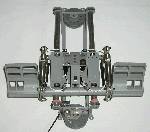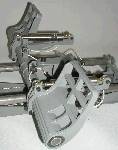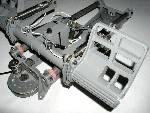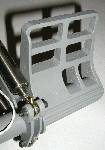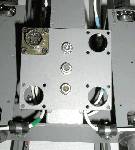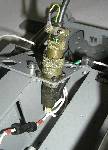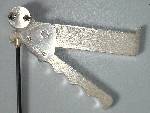I have been using the RCS from Thrustmaster for a long time. These were the only pedals I knew, that
had a distance of more than 18 cm. between the pedals, and therefore could fit behind the center
console of the simulator. The pedals themselves were fine, more or less stale construction, but also
a little expensive. Two things bathered me about them:
- Movement was extremely big
- They had no braking function
A further problem appeared, when I had visitors that wanted to fly my simulator (by the way, all of
us that have a simulator know this "problem" of friends wanting to fly themselves ;-). Here the problem
arised, that the pedals were fixed for my personal size. Many visiting pilots were either smaller or
bigger than me, and therefore had problems with the position of the pedals in the simulator. Please notice,
that also in the real F-16 you cannot adjust the ACES II in the horizontal position. You can only
adjust the height with the "Seat Adjust Switch" on the right side of the cockpit. Due to the
inclination of 30° of the ACES, each height adjustion of 3 cm gives bearly 1 cm horizontal
adjusting. This would not be enough to adjust the pedal position to an optimum. To do this in the
real plane, you have to use the
Pedal Adjust Handle.
Due to this, I knew, that my next set of pedals would have to cope with the following conditions:
- Minimum distance between pedals of 20 cm (because of the center console)
- Maximum depth of the system of 50 cm (unfortunately there is no more space available in the front)
- Toe-brakes for each wheel
- Adjusting capabilities
- Little movement (if possible "force operated")
The best of course, would be to get the original rudders of the F-16. In order to achieve this I
consulted all my contacts and resources, as well as bids, but could not find anything. Those pedals
that were offered had either a horrendous price over US $2000 and were in a terrible condition.
Thanks to a friend of mine, I heard about a company in Spain, called
RealSimulator. These guys had the aim of
building a high fidelity F-16 cockpit. The first part they would produce were the rudder-pedals.
I started to inform myself about them on their HP (
http://www.realsimulator.com),
and what I found on their site gave me two shocks at the same time. On one hand the a perfect copy
and functionality, on the other hand the price of them ;-). One interesting thing was the fact, that
you could get your pedals as modules. Rudder pedals, toe-brakes and adjusting basis could be bought
separately, according your needs and budget.
But I wanted and needed (see my conditions mentioned above) the Deluxe version (yes, yes, I want
them, I want them, I want them ;-))). After several consulting with my "internal" ;-) and external
banking accounts, and having decided to cancel my next vacation trip in the next year, I made my
mind up to buy the pedals. I contacted Manuel Orcera, who answered all my questions and gave me all
the required information I needed. We agreeded a good price (yes, you have read correctly, you can
get an agreement with those gentlemen) and I ordered the Deluxe vVersion. The transport and insurance
via FedEx was kind of expensive, and therefore you should look for alternatives. I had some bad
experiences with the "normal" postal service, and this time I did not wanted to risk anything, to
make sure that my investment would really arrive.
After a few day I received a huge and heavy package. Just having a look on the package itself, you
could tell that RealSimulator was delivering high quality. The pedals were shipped like if they were
an extreme delicate optical device, with all kinds of protective material enclosing the pedals.
Packed this way, the pedals could resist a permanent travelling for the next 10 years :-).
Now, about the pedals; to make it short:
They are just a dream!!!!
They are a perfect copy of the type 43 of the F-16 and almost 100% full metal version.
Therefore they are robust and stable. Here some technical data about these pedals:
- Length: 55,0 cm
- Width: 47,4 cm
- Height: 21,0 cm
- Space between the pedals: 25,5 cm
- Weight: aprox. 10 kg
- Adjusting range: 22,0 cm
- Movement range: +-10 Deg.
- Req. pressure for rudder action: 20,0 kg
- Max. braking range: 20 Deg.
- Req. pressure for braking action: 17,5 kg
The connection is easily achieved with a 15 sub-d connector inserted into the Cougar's Rudder-port.
After a small modification of the configuration file, the braking action is available. If you want to
connect the rudders directly to an EPIC card, there is the need of building a simple adapter. This I
think will be not a problem for the EPIC users. A cable of about 2m is included, which has on one
end a 6poe MIL-C26482 connector. This is connected to the rudders. For this purpose a receptacle for
the connector is on top of a plate of the rudders, which has as the original plate 4 drillings, but
it this copy just requires one. This detail by itself, shows the high fidelity that was achieved by
the Spanish company.
The movement is due to the used 100k sliding linear potentiometers like on the real F-16, very short and
require precise handling. For those who used other pedals this will require to get used to the new
pedals first, as more force than movement is required on this system (same as in the F-16 stick).
The used potentiometers used in these ruder pedals are not force-transducers, but simulate this
feature very well. I am sure, that once you got used to them, you will not miss them any longer.
The braking action is not simply given by a switch; it is given by the same 100k sliding linear
potentiometers. Therefore the action is not just an ON / OFF function, but allow a progressive and
selective braking of each wheel. Falcon 4.0 (SP3) does not support yet the differential braking, but
I am sure, this is just a matter of time ;-) "Pilots" of other flight simulators, (as FS2002) will
already be able to enjoy this feature. Being a private pilot myself, I can only say that the
feeling of the braking feature is phantastic.
The pedal adjusting is just the same as in the real F-16, achieved by sliding on a rail system,
aprox 40 cm long. By means of a cable and spring the pedals are drawn in direction of the pilot.
Applying pressure on the pedals, the pilot can achieve the needed position. Once the pedal adjust
handle is released, the pedals are locked in the present position. This adjusting cable and handle
is also delivered with the rudder-pedal set. Instead od a handle, a device that looks like a pair of
players is delivered, and this is my only point of critics. It would have looked much better if a
copy of the handle was delivered instead. I think this would not be too expensive and the
simulator-builders would have a 100% perfect system. Perhaps it will be delivered this way in the
future ;-).
The first time I used the pedal adjust, I was scared like hell, as I did not have my feet on the
pedals when I did. The pedals slipped back with a big noise. The spring was much stronger, that I
had thought. Fortunately the very solid construction of the pedals could take this (by the way they
are guarantee for 2 years!). Therefore, when you adjust your pedals, PUT your feet on them first ;-).
Well, after many tests and flights with the pedals, I have to say that they are 100% worth their
price! I do not regret to have bought them and can only recommend every sim-builder to get his own
set.
When Manuel Orcera from RealSimulator made his calculations, he based his numbers on a small number
of sets. If more people are interested in the pedals, the price might get lowe. Dieter "Phaser"
(
http://www.phaser-dbs.de) is planning to bundle some
requests and hopes to get a good discount for all of us (around 20%). If there is some interest on
your side, contact Dieter "Phaser" E-Mail
phaser.dbs@t-online.de.










